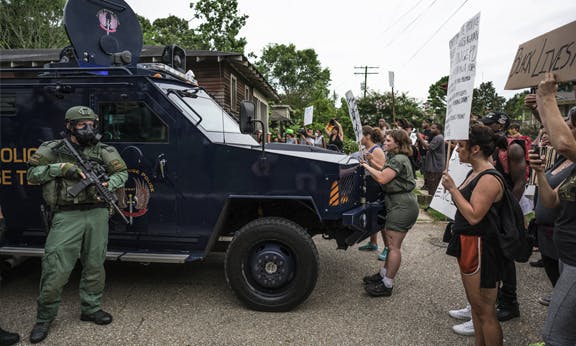Black Lives Matter defies intimidation

Once again the deep racism and racial divide in the United States have burst upon the national scene.
Since 2014, videos taken by witnesses of police murders of Black people have spurred the rise of the Black Lives Matter movement. In spite of overwhelming visual proof of the guilt of the police murderers, almost all have gotten away with it. This has emboldened the police – they know they can kill Blacks with impunity.
This explains why two cops in Baton Rouge, Louisiana, thought nothing of killing 37-year-old Alton Sterling while he was on the ground incapacitated. Two videos were taken of the event, which showed two cops kneeling on top of Sterling. One of them took out his gun and pumped three bullets into him. This happened on 5 July.
The next day in Minnesota, a cop pulled over Philando Castile for a broken taillight. In the car were his fiancé, Diamond Reynolds, and her four-year-old daughter.
The cop shot Castile as he reached for his wallet to produce his licence and registration. Reynolds, to protect herself and her child, started to video the dying man and the cop, who then pointed his gun at her. What the cop didn’t know was that her video was being live-streamed to her Facebook friends, who sent it out; soon it became known to millions.
These two police murders sparked protests of tens of thousands in cities across the country. At one of these, in Dallas, Texas, an African American Army veteran, Micah Johnson, opened fire on police with military precision, killing five and wounding another seven.
The police say Johnson wanted to kill white police officers in retaliation for the police murder of Blacks. Acquaintances and relatives say he had come back from Afghanistan a changed man. It is not surprising that an individual with emotional problems in this polarised atmosphere would decide to carry out such an action, however misguided and harmful to the cause. We may see more such incidents.
This then became the major story in the media, swamping the two police murders. In spite of the fact that Johnson was not part of the demonstration and had nothing to do with Black Lives Matter, many jumped on the incident to charge that it was the protesters and BLM that were to blame.
Edward Luce wrote in the Financial Times: “In response to the Blacks Lives Matter movement, there is now a Blue Lives Matter campaign for the police. A number of Republican figures, including the lieutenant governor of Texas, have blamed the killings on Black Lives Matter at whose protest they took place. The internet is awash with invented stories of how the group incites its supporters to attack the police”.
In the face of this racist onslaught, the protests against police violence were not deterred. Following the Dallas shootings, tens of thousands took to the streets and blocked roads, bridges and highways in more than a dozen cities. Hundreds were arrested.
In this situation of increasing polarisation, Republican presidential candidate Donald Trump emphasised his previous position that he stands with the police against Black Lives Matter. He says that he is the “law and order” candidate.
President Obama and Democratic candidate Hillary Clinton say that the problem is the result of a lack of communication between the police and the Black community, and urge “both sides” to reconcile.
The real problem can be seen through a closer look at the situation in Dallas. There has been a massive media campaign emphasising the “irony” that the killing of police occurred in Dallas, where such great progress has been made. The city even has a Black police chief.
An article in the New York Times dug a little deeper: “[F]or all the progress that the Dallas police have made, this remains one of the most segregated big cities in the country, with yawning racial gaps in housing, schools and employment.
“Decades of discriminatory federal, state and local policies have concentrated the city’s black population in deeply poor and underdeveloped neighbourhoods south of Interstate 30, which serves as a line of demarcation between opportunity and neglect. While downtown Dallas is flush with glassy skyscrapers and high priced restaurants, large tracts of the city’s southern sector are empty and ragged.
“‘People look at the Blacks Lives Matter movement as people protesting against police brutality’, said Terry Flowers, the executive director and headmaster of St. Phillips School and Community Center in South Dallas. ‘I think it is much larger than that. People are protesting against a social engineering of inequity.’”
What is termed the Black community is in reality a concentration of Blacks in ghettos with high unemployment, poverty and resultant street crime made worse by the so-called war on drugs. The police are charged with enforcing this segregation and keeping the lid on the ghettos. They act as an occupying force, with daily harassment, arrests, beatings and even murder. While segregation by law was defeated by the mass civil rights and Black liberation movements of the 1960s, de facto segregation is more pronounced today than in 1970.
Blacks who escape from the ghettos and have gotten better paying jobs, largely the result of the gains of earlier Black movements, are also swept up in this institutional, structural racism, which is deeply embedded in 400 years of US capitalism.
It will take more than “better communication” to break this down.